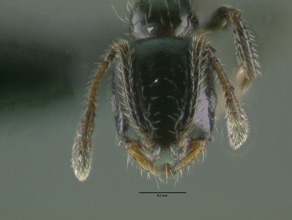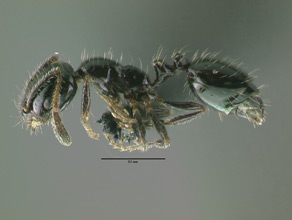- Identification
- Small, shiny-black ants with a bluish tint. Antenna are 12 segmented with a three segment club that has increasingly larger segments towards its distal end.
- Biology
- Wheeler (1914) stated these ants "nested under stones in more damp places on the sides of canyons." DuBois (1986) also found this to be the case in collections he made. One nest was described in some detail (the following text is modified from that account): most of the nest occupied an area about 10 cm in diameter, about 5 cm from an Iridomyrmex pruinosus nest chamber found under the same rock. The visible portions of the Monomorium cyaneum nest consisted of a series of small, 1 cm in diameter, chambers that were connected by 3 mm diameter tunnels no more than 5.2 cm in length. The nest extended at least a tenth of a meter underground.
- additional biology notes...
- Distribution
- Range
- United States. From central Mexico northward to Texas, New Mexico and Arizona.
- Navajo Reservation Records
- Samples being processed.
- Additional Notes
- Mackay and Mackay (2002) report this species occurs in a wide variety of habitats: "grasslands, sagebrush, pinyon-pine and to wet mid altitude ponderosa pine forests, to urban habitats, it is most common in semiarid habitats." They also state: "This species normally nests under stones (or logs), but may have a simple nest in the soil, surrounded by a small mound. Brood was found in nests in June to August, sexuals were in nests in July. A dealate female was collected in August. One colony was collected together with Formica fusca, a second with Acanthomyops coloradensis. Gregg 1963 (M. viridum peninsulatum)."
- Multiple queens have been found in nests, one queen to a nest chamber and each individual surrounded by eggs. DuBois (1986) states Gynes are wingless yet the synonomized variety Monomorium minimum subsp. emersoni was described as having winged gynes (Gregg, 1945).
- Etymology
- Morphological. The workers have a bluish tint.
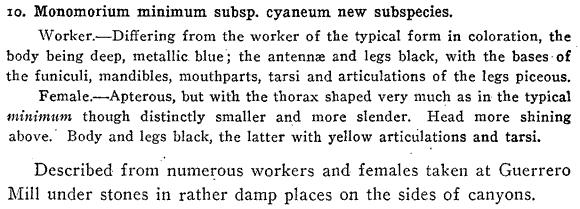
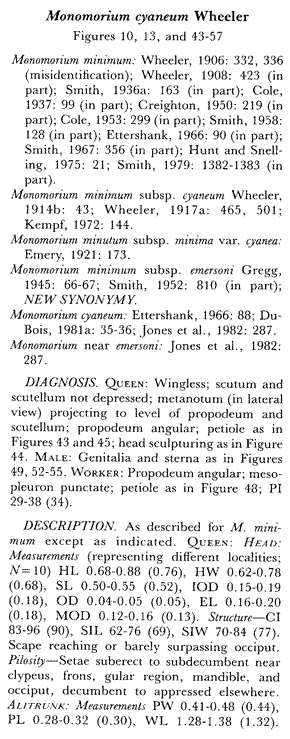
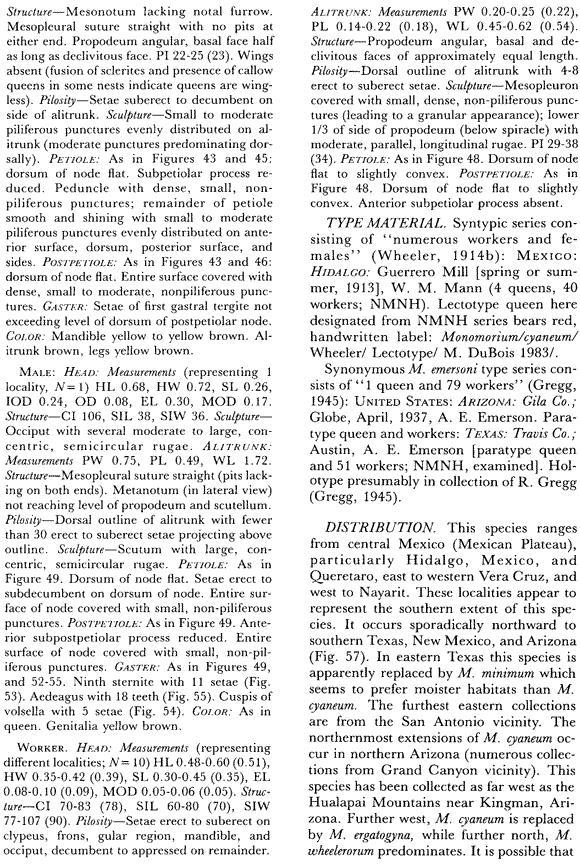

- Literature
- DuBois, M. B. 1986. A revision of the native New World species of the ant genus Monomorium (minimum group) (Hymenoptera: Formicidae). University of Kansas Science Bulletin. 53:65-119.
- Gregg, R. E. 1945. Two new forms of Monomorium (Formicidae). Psyche (Cambridge). 52:62-69.
- Mackay, W. P. and E. Mackay. 2002. The ants of New Mexico (Hymenoptera: Formicidae). Edwin Mellen Press, Lewiston, NY.
- Wheeler, W. M. 1914. Ants collected by W. M. Mann in the state of Hidalgo, Mexico. Journal of the New York Entomological Society. 22:37-61.
- A note about these publications. The literature cited here is not meant to be an exhaustive list of papers published about this species.
Page authored by David Lubertazzi and Gary Alpert
